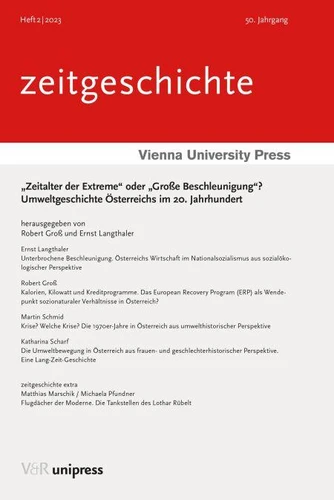"Zeitalter der Extreme" oder "Große Beschleunigung"?. Umweltgeschichte Österreichs im 20. Jahrhundert
Par : , ,Formats :
Disponible dans votre compte client Decitre ou Furet du Nord dès validation de votre commande. Le format PDF est :
- Compatible avec une lecture sur My Vivlio (smartphone, tablette, ordinateur)
- Compatible avec une lecture sur liseuses Vivlio
- Pour les liseuses autres que Vivlio, vous devez utiliser le logiciel Adobe Digital Edition. Non compatible avec la lecture sur les liseuses Kindle, Remarkable et Sony
 , qui est-ce ?
, qui est-ce ?Notre partenaire de plateforme de lecture numérique où vous retrouverez l'ensemble de vos ebooks gratuitement
Pour en savoir plus sur nos ebooks, consultez notre aide en ligne ici
- Nombre de pages154
- FormatPDF
- ISBN978-3-8470-1567-3
- EAN9783847015673
- Date de parution12/06/2023
- Protection num.pas de protection
- Taille3 Mo
- Infos supplémentairespdf
- ÉditeurV&R Unipress
Résumé
Das stille Nebeneinander von Zeit- und Umweltgeschichte hat sich in den letzten Jahren in Richtung eines beredten Austauschs bis hin zu punktueller Kooperation gewandelt. Dazu beigetragen haben nicht nur gesellschaftlich wirkmächtige Umweltfragen wie die "Klimakrise", sondern auch der Umweltgeschichte zugehörende oder nahestehende Historiker:innen des 20. Jahrhunderts. Die Beiträge dieses Heftes erkunden das Erkenntnispotenzial eines umwelthistorischen Blicks auf Österreich im 20.
Jahrhundert anhand verschiedener Themen: die Ressourcenmobilisierung und dagegen erhobene Proteste im Nationalsozialismus, die Beschleunigung der Material- und Energieflüsse und daran entzündete Debatten durch den Marshall-Plan, der gesellschaftliche Naturverbrauch und die mobilisierte Umweltbewegung in den 1970er-Jahren sowie fotografische Repräsentationen der österreichischen Petro-Moderne. The silent coexistence of contemporary and environmental history has changed into an eloquent exchange and has initiated several cooperations in recent years.
This is due both to socially-influential environmental challenges as the "climate crisis" and 20th century historians who are closely linked with environmental history. The contributions in this issue explore the potential of an environmental-historical view of Austria in the 20th century on the basis of various aspects: the mobilisation of resources and protests against it during Nazism, the acceleration of material and energy flows and the respective debates ignited by the Marshall Plan, the social consumption of nature and the mobilised environmental movement in the 1970s, as well as photographic representations of Austrian petro-modernity.
Jahrhundert anhand verschiedener Themen: die Ressourcenmobilisierung und dagegen erhobene Proteste im Nationalsozialismus, die Beschleunigung der Material- und Energieflüsse und daran entzündete Debatten durch den Marshall-Plan, der gesellschaftliche Naturverbrauch und die mobilisierte Umweltbewegung in den 1970er-Jahren sowie fotografische Repräsentationen der österreichischen Petro-Moderne. The silent coexistence of contemporary and environmental history has changed into an eloquent exchange and has initiated several cooperations in recent years.
This is due both to socially-influential environmental challenges as the "climate crisis" and 20th century historians who are closely linked with environmental history. The contributions in this issue explore the potential of an environmental-historical view of Austria in the 20th century on the basis of various aspects: the mobilisation of resources and protests against it during Nazism, the acceleration of material and energy flows and the respective debates ignited by the Marshall Plan, the social consumption of nature and the mobilised environmental movement in the 1970s, as well as photographic representations of Austrian petro-modernity.
Das stille Nebeneinander von Zeit- und Umweltgeschichte hat sich in den letzten Jahren in Richtung eines beredten Austauschs bis hin zu punktueller Kooperation gewandelt. Dazu beigetragen haben nicht nur gesellschaftlich wirkmächtige Umweltfragen wie die "Klimakrise", sondern auch der Umweltgeschichte zugehörende oder nahestehende Historiker:innen des 20. Jahrhunderts. Die Beiträge dieses Heftes erkunden das Erkenntnispotenzial eines umwelthistorischen Blicks auf Österreich im 20.
Jahrhundert anhand verschiedener Themen: die Ressourcenmobilisierung und dagegen erhobene Proteste im Nationalsozialismus, die Beschleunigung der Material- und Energieflüsse und daran entzündete Debatten durch den Marshall-Plan, der gesellschaftliche Naturverbrauch und die mobilisierte Umweltbewegung in den 1970er-Jahren sowie fotografische Repräsentationen der österreichischen Petro-Moderne. The silent coexistence of contemporary and environmental history has changed into an eloquent exchange and has initiated several cooperations in recent years.
This is due both to socially-influential environmental challenges as the "climate crisis" and 20th century historians who are closely linked with environmental history. The contributions in this issue explore the potential of an environmental-historical view of Austria in the 20th century on the basis of various aspects: the mobilisation of resources and protests against it during Nazism, the acceleration of material and energy flows and the respective debates ignited by the Marshall Plan, the social consumption of nature and the mobilised environmental movement in the 1970s, as well as photographic representations of Austrian petro-modernity.
Jahrhundert anhand verschiedener Themen: die Ressourcenmobilisierung und dagegen erhobene Proteste im Nationalsozialismus, die Beschleunigung der Material- und Energieflüsse und daran entzündete Debatten durch den Marshall-Plan, der gesellschaftliche Naturverbrauch und die mobilisierte Umweltbewegung in den 1970er-Jahren sowie fotografische Repräsentationen der österreichischen Petro-Moderne. The silent coexistence of contemporary and environmental history has changed into an eloquent exchange and has initiated several cooperations in recent years.
This is due both to socially-influential environmental challenges as the "climate crisis" and 20th century historians who are closely linked with environmental history. The contributions in this issue explore the potential of an environmental-historical view of Austria in the 20th century on the basis of various aspects: the mobilisation of resources and protests against it during Nazism, the acceleration of material and energy flows and the respective debates ignited by the Marshall Plan, the social consumption of nature and the mobilised environmental movement in the 1970s, as well as photographic representations of Austrian petro-modernity.




